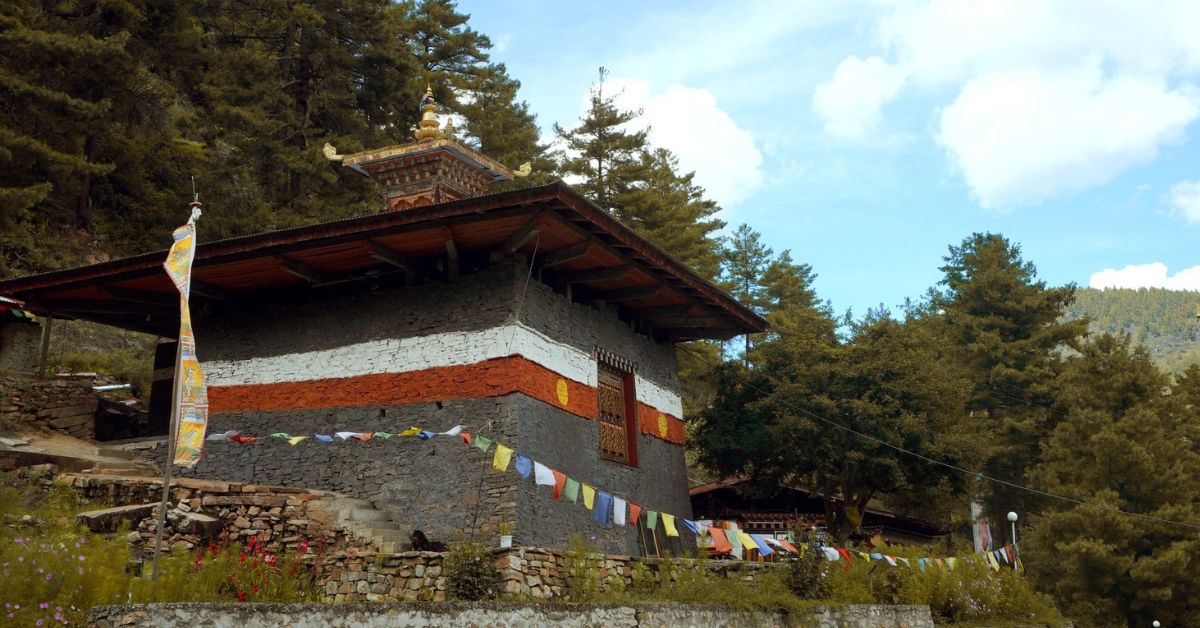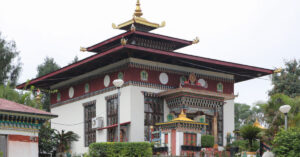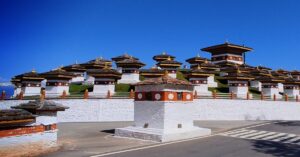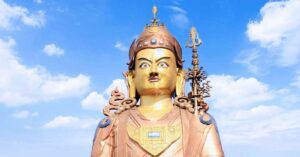Lhakhang Nagpo, also known as the “Black Temple”, is a one-story temple founded by Songtsen Gampo in 659 CE. The temple is located in the Haa Valley at an elevation of 3,366 meters. It was built as part of the 108 temples in the Himalayan region to subdue a demoness disrupting the spread of Buddhism.
With its counterpart, Lhakhang Karpo (White Temple), the Black Temple is located at the base of the revered Meri Puensum Mountains in Dumchoe village of Uesu Gewog, under Haa Dzongkhag.
Among the 108 temples built in Bhutan, the most well-known temples are Kyichu Lhakhang in Paro and Jambay Lhakhang in Bumthang. Other lesser-known temples include Khiney Lhakhang in Lhuentse and Konchogsum Lhakhang in Bumthang.
How to Reach Lhakhang Nagpo
The Lhakhang Nagpo is located 10 minutes north of the Lhakhang Karpo at the base of Mount Meri Puensum.
Sacred Relics to See at Lhakhang Nagpo
- Jowo Skyamuni (historical Buddha);
- Tadin (Hayagriva);
- Chana Dorji (Vajrapani);
- Buddha of Expiratory Rituals deities;
- Statue of Zhabdrung Rinpoche, Songtsen Gampo, and Guru Padmasambhava;
- Pal Yeshey Gempo’s La-tsho;
- Pel Yeshey Gempo’s Rangjung Kilkor (Mahakala’s Mandala);
- Be-dang-kha, the ‘subdued place of the snake’.
Historical Background of Lhakhang Nagpo
Lhakhang Nagpo (Black Temple) was built by Songtsen Gampo, the Dharma King, in 659 CE.
According to the history of Lhakhang Nagpo, the Black Temple was founded by Songtsen Gampo, the Tibetan Dharma King, in the 7th century. The temple was built as a part of a project to build 108 temples in a single day, aimed at subduing an ogress who opposed the propagation of Buddhism in the Himalayan region.
It is said that Songtsen Gampo released a black pigeon to select the destined site, and the bird landed at the foothills of the Meri Puensum mountains. The temple was then constructed over a lake. The temple was named Lhakhang Nagpo, meaning “Black Temple,” referring to the black pigeon.
Initially, the Lhakhang Nagpo was maintained by the Kiri village community with Boepa Lodrue as the first lama and Nagay as the second Lama. Later, the community handed it over to the Zhung Dratshang, which subsequently appointed Ponpung as the first lama, followed by Lam Tshering Nidup and Lam Penchu.
Description of Lhakhang Nagpo
The main relic of Lhakhang Nagpo is a statue of Jowo Shakyamuni.
Lhakhang Nagpo is a small, one-story, rectangular structure built in the traditional Tibetan Buddhist architectural style. It has a flaring jabzhi-style roof, topped by an ornamental lantern capped with a gilded sertog. The outer walls of the Lhakhang have only two openings, a small door and a window. The stonework is painted with a double khemar band in red and white, featuring golden medallions in place of the traditional circular copper plates.
Inside, the main relic is Jowo Shakyamuni, said to be identical in terms of size, height, and appearance to the Jowo Shakyamuni at Lhasa, except for the ornaments. Therefore, it is believed that receiving blessings from the Jowo of Lhakhang Nagpo carries equal merit as visiting the one in Lhasa.
A popular legend has it that during the plague epidemic in the early 1980s, the people of Haa survived as the Jowo took the disease. The marks left by the disease on the abdomen of the Jowo are still visible to this day.
The other important relics are Tadin (Hayagriva), Chana Dorji (Vajrapani), and the deities of Expiratory Rituals. Lhakhang Nagpo also features statues of Zhabdrung Rinpoche, Songtsen Gampo, and Guru Rinpoche, which were recently installed. It also features mural paintings of Zhabdrung Phunseum Tshogpa, Neten Chudruk (Sixteen Arhats), and Mithrugpa Lhatshog (Aksobhya Buddha).
Pal Yeshey Gempo’s La-tsho
An opening in the temple’s floor leads to the Pal Yeshey Gempo’s La-tsho. It is a home to a protecting deity, Tshomen Dechen Gyalpo. A concrete protection and a glass cover were installed to prevent offerings, such as milk or money, from entering the lake.
Pel Yeshey Gempo’s Rangjung Kilkor (Mahakala’s Mandala)
Just above the temple is Pel Yeshey Gempo’s Rangjoen (natural raising) Kilkor (mandala) on the rock, painted in gold. It is said that a crow appeared while people were performing a smoke offering ritual, making them believe it was a Choechong Sungma (guardian deity). Even today, the community continues a tradition of Ola-chag-tshel-lo, an offering made to a crow.
Be-dang-kha, the “subdued place of the snake”
A 15-minute walk northwest of the Lhakhang Nagpo leads to the sacred site of Be-dang-kha, meaning the “subdued place of the snake”, located at Yipri (now Kipri). An oral tradition holds that in the 8th century, Guru Rinpoche subdued a demonic serpent, a present-day deity of Shelkar Drak Lhakhang, that haunted the villagers, thereby restoring the community to normalcy.
The rock still bears the imprint of the serpent and the body print of Guru Rinpoche. Locals say that even today, people with low Lung-ta (win-horse) can see the snake (a bad omen), while those with high Lung-ta may see the Dungkar (conch), symbolizing a good omen.
Renovations of Lhakhang Nagpo
Minor renovation work was undertaken in 2019, including re-roofing with metal sheets and repainting the wall. A lama’s residence, a kitchen, and a toilet were added in front of the Lhakhang.
Festivals and Rituals of Lhakhang Nagpo
Lhakhang Nagpo conducts a variety of rituals throughout the year, including:
- Yarngo and Marngo, a monthly practice dedicated to the triple gem and all sentient beings by performing rituals of Tshepai (Buddha of Longevity ritual) and Neten chudruk chokha (sixteen arhats).
- The Zhabdrung Dhanangmai ritual is performed on the 3rd Month of the Bhutanese calendar.
- Namjom and Tshepai rituals are observed in the 4th month of the Bhutanese calendar.
- Invocation to Pal Yeshey Gonpo (Mahakala) is conducted on the 10th month of the Bhutanese Calendar.
Best Time to Visit Lhakhang Nagpo
While Lhakhang Nagpo is a year-round destination, the best time to visit is during the autumn months (September-November). This period offers clear skies and pleasant weather, coinciding with the vibrant Haa Tshechu Festival. You can visit the major pilgrimage sites of Haa with the Bhutan Pilgrimage Package.
Places to Explore in Haa
Rangtse Ney: A sacred abode of Guru Rinpoche located in Chego village under Haa Dzongkhag at an altitude of 879 meters above sea level.
Shelkar Drak Lhakhang: A small temple built on a cliffside in Haa, founded by Choglay Jigme Tenzin, the sixth speech incarnation of Zhabdrung Rinpoche.
Lhakhang Karpo: Also known as the “White Temple”, it is a one-story temple founded by Songtsen Gampo in 659 CE to subdue a demoness in the Haa Valley.
Jo Bay Tsho: A hidden lake that stretches approximately 300 by 200 meters in length, nestled along the border of Sombaykha and Gakiling Gewogs in Haa.
Enjoyed reading this blog?




